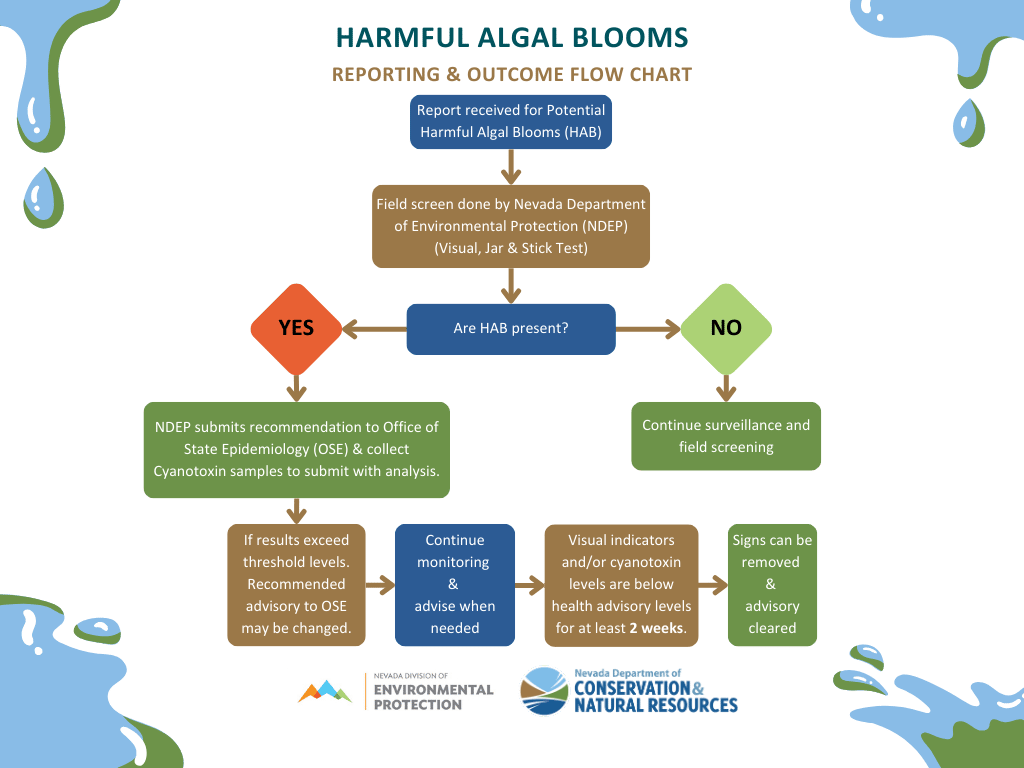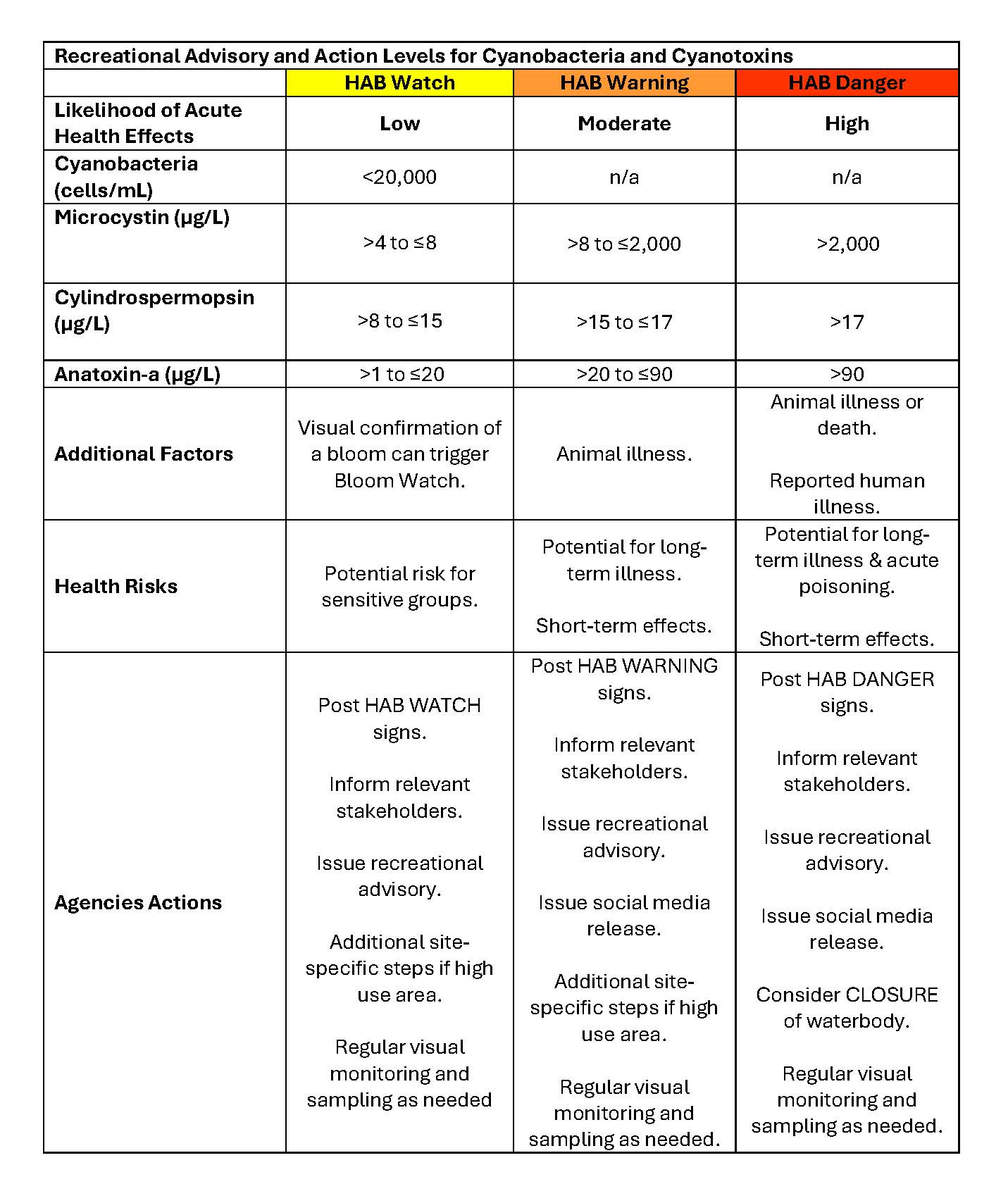Harmful Algal Blooms
 |
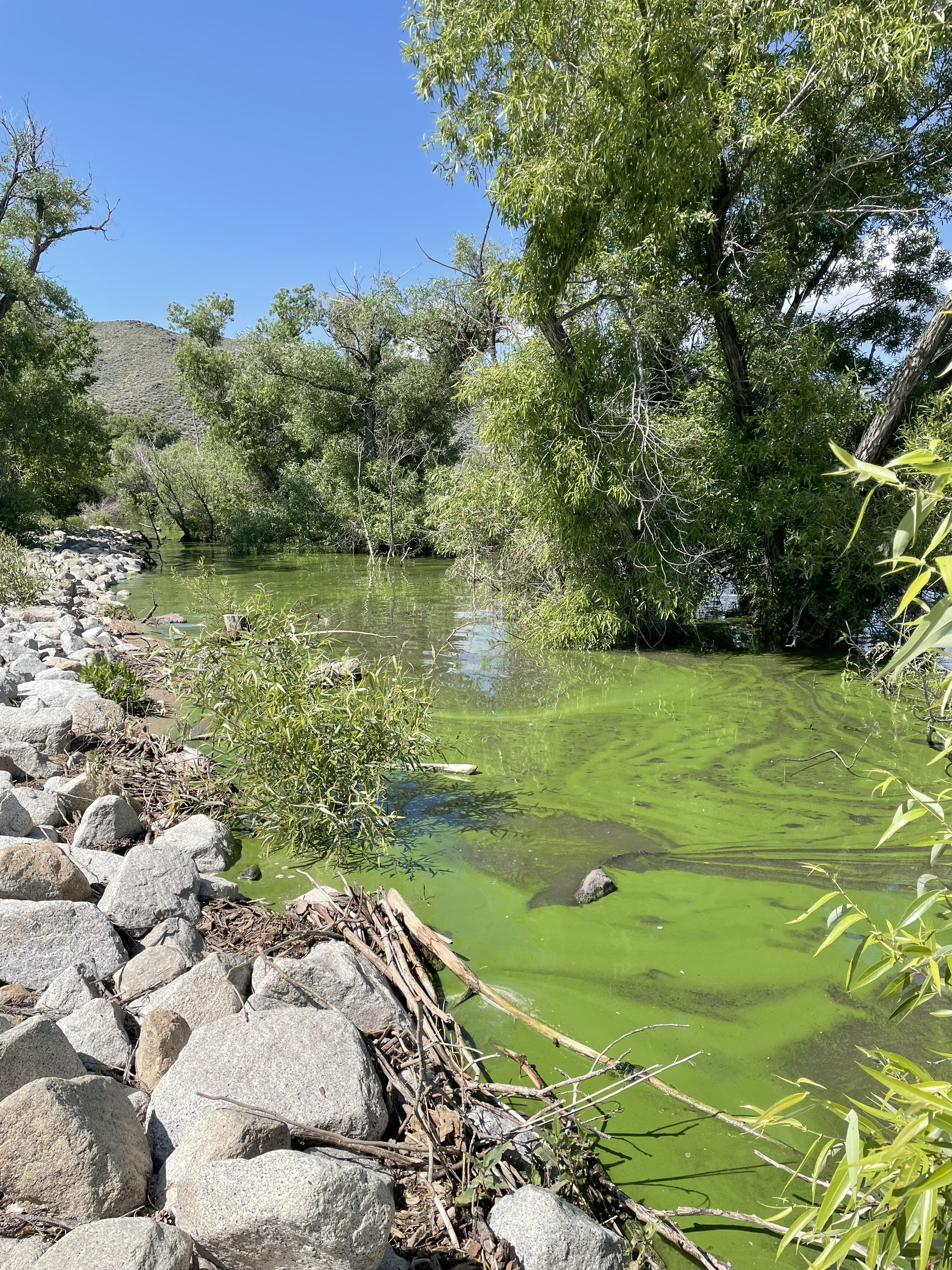 Harmful algal blooms (HABs), primarily caused by cyanobacteria (also known as blue-green algae), are a growing concern in Nevada's freshwater bodies, particularly during late summer and early fall. These blooms can produce toxins harmful to humans, animals, and aquatic life. The Nevada HAB Task Force provides resources and information to help the public stay safe, including advisories for specific water bodies.
Harmful algal blooms (HABs), primarily caused by cyanobacteria (also known as blue-green algae), are a growing concern in Nevada's freshwater bodies, particularly during late summer and early fall. These blooms can produce toxins harmful to humans, animals, and aquatic life. The Nevada HAB Task Force provides resources and information to help the public stay safe, including advisories for specific water bodies.
HAB FAQs
Are there currently any HAB watches, warnings or dangers in Nevada?
The Nevada HAB Task Force provides weekly HAB updates. View the graphic for any current HAB watches, warnings or dangers.
| WEEKLY HAB REPORT | |
Echo Canyon Reservoir - 6/30/25Eagle Valley Reservoir - 6/24/25 | |
 | Lahontan Reservoir - 7/1/25 |
 | None |
Please subscribe to the email list at the bottom of the page to receive weekly HAB updates via email. View the Nevada HAB dashboard for a map of Nevada's waterbodies and current HAB status.
What are cyanobacteria and harmful algal blooms (HABs)?
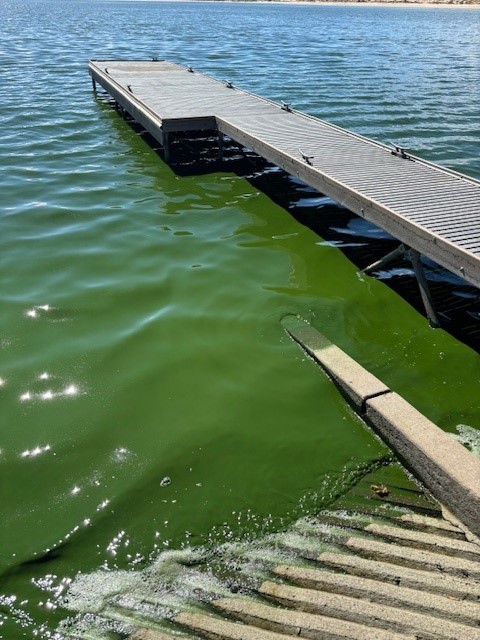 Cyanobacteria (also known as blue-green algae) and algae occur in freshwater and estuarine waterbodies. Algae and cyanobacteria have been around for billions of years and are natural components of ecosystems. They perform many roles that are vital to our aquatic communities, by being a food source and producing oxygen. However, when conditions are favorable, cyanobacteria can grow rapidly, causing algae blooms. Cyanobacteria can produce harmful toxins that cause health risks to humans and animals. When blooms pose a risk to humans, animals, and the environment, they are referred to as harmful algal blooms (HABs). Some algae grow attached to the bottom (benthic) and can form algal mats. Toxicity can be hard to predict because a single species of algae can have both toxic and non-toxic strains, and a bloom that tests non-toxic one day can be toxic the next. Because it is hard to tell whether an algal bloom is harmful or not it is recommended to avoid contact with any floating mats, scums, and discolored water.
Cyanobacteria (also known as blue-green algae) and algae occur in freshwater and estuarine waterbodies. Algae and cyanobacteria have been around for billions of years and are natural components of ecosystems. They perform many roles that are vital to our aquatic communities, by being a food source and producing oxygen. However, when conditions are favorable, cyanobacteria can grow rapidly, causing algae blooms. Cyanobacteria can produce harmful toxins that cause health risks to humans and animals. When blooms pose a risk to humans, animals, and the environment, they are referred to as harmful algal blooms (HABs). Some algae grow attached to the bottom (benthic) and can form algal mats. Toxicity can be hard to predict because a single species of algae can have both toxic and non-toxic strains, and a bloom that tests non-toxic one day can be toxic the next. Because it is hard to tell whether an algal bloom is harmful or not it is recommended to avoid contact with any floating mats, scums, and discolored water.
What do Harmful Algal Blooms look like?
Harmful algal blooms can look like pea soup, foam, spilled paint, grass clippings, or mats on the surface of water and can be different colors.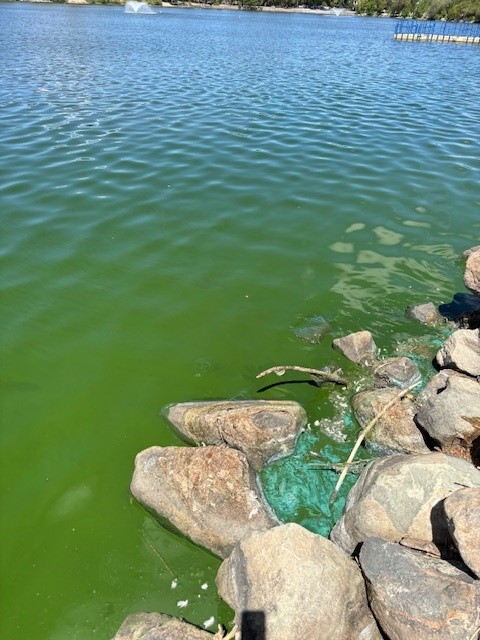
Sometimes the bloom is easily visible, forming “scum” or discoloration on the water surface. Other times, it is less visible, floating beneath the surface or on the bottom of a water body (benthic). Blooms can appear green, blue, yellow, red, or brown. Cyanotoxins, produced by cyanobacteria, cannot be visually detected in water or tissues.
When and where do HABs occur in Nevada?
Blooms in Nevada occur in freshwater, such as lakes, ponds, streams, and rivers. They can occur any time throughout the year although the conditions that lead to harmful algal blooms generally occur in the late summer and early fall. These conditions include:
- High nutrient levels
- Abundant sunlight
- Warm water temperatures
- Stagnant or slow-moving waters
If these conditions are present for several days, cyanobacteria can multiply to form large blooms that can cover an entire lake or collect in smaller areas. Blooms generally die and disappear after one or two weeks.
How can I recreate safely in Nevada's waterbodies?
If you suspect a harmful algal bloom, you can take the following precautions:
- Don’t swim in the water.
- Don’t boat, water ski, or jet-ski on scummy water. These activities can cause toxins to become airborne, increasing the likelihood you will inhale them.
- Don’t let children play with scum on the water or along the shore.
- Don’t let pets or livestock swim in or drink from scummy water.
- Don’t boil the water in an attempt to remove toxins as boiling can release more toxins.
- HABs may not be visible to the naked eye and the water may still contain hazardous toxins. You can check for Nevada issued swimming advisories on the Nevada HAB Dashboard.
Regardless of a harmful algal bloom people should take the following precautions every time they have contact with recreational lakes, ponds, streams, or rivers:
- Check for local and state swimming or fishing advisories prior to visiting lakes, rivers etc.
- Don’t swallow water when swimming.
- Shower after coming into contact with recreational water.
- Rinse animals immediately if they swim in recreational water.
- Wash hands with clean water before eating or preparing food.
- Clean waterfowl and fish well with clean water and discard the guts.
- Never drink recreational water.
- Wash dishes with clean water. Do not use recreational water.
- When in doubt, stay out.
What are the symptoms of exposure to a Harmful Algal Bloom?
When people are exposed to cyanotoxins, adverse health effects may range from a mild skin rash to serious illness or in rare circumstances, death. People exposed through direct skin contact, ingestion or inhalation may experience irritation of the skin, eyes, nose, throat, and/or respiratory tract. Symptoms to look for include:
- Rashes, hives, or blisters
- Runny nose, sore throat, asthma, or allergic-like reactions
People exposed through ingesting cyanotoxins may experience:
- Abdominal pain
- Headache
- Neurological symptoms
- Vomiting
- Diarrhea
- Liver damage and/or kidney damage
How do I protect my pets against Harmful Algal Blooms and what exposure symptoms should I watch for?
Pets and companion animals can be exposed to cyanobacteria or toxins by skin contact with contaminated water, when swallowing contaminated water while playing in the water, or by licking it off fur or hair. It is important not to let pets play, swim, or drink water that smells bad, has a strange color, appears slimy, foamy, or has mats or scum. It is advisable that you do not let your pet eat dead animals, such as fish found near the bloom or eat mats of cyanobacteria. Prevention is the best way to protect pets because most exposures are fatal even with proper veterinary care.
If you think your pet or companion animal has been exposed to a harmful algae bloom rinse them off immediately in clean fresh water. Wear gloves while rinsing your pet to protect yourself from exposure. Watch for symptoms that pets may exhibit after being exposed to cyanotoxins. Symptoms can arise anywhere from 15 minutes to several days after exposure. Take pets to the vet immediately if they show any of these signs:
- Weakness
- Staggering
- Difficulty breathing
- Drooling
- Vomiting
- Diarrhea
- Convulsions
- Loss of appetite
- Foaming at the mouth
- Excessive drooling
- Tremors and seizures
Where do I report a possible exposure?
- If you are experiencing symptoms after being exposed to a harmful algal bloom, contact your physician, and seek care immediately.
- If your pet is exhibiting signs of illness after being exposed to a harmful algal bloom, contact a veterinarian, and seek care immediately.
- Report harmful algal blooms to Nevada Department of Environmental Protection (NDEP): 888-331-6337
- Report sick or dead wildlife to Nevada Department of Wildlife (NDOW): 775-688-1500
- If you have any questions about cyanobacterial toxin poisoning, call Poison Control at 1-800-222-1222
- Report human and domestic animal illnesses, email stateepi@health.nv.gov.
What causes HABs?
Increased inputs of nutrients like nitrogen and phosphorus (from fertilizers and human or animal wastes) promote cyanobacterial growth and can lead to increased occurrences of HABs. Low flows, stagnant water, increased intensity, and duration of sunlight, and sustained high temperatures create the ideal conditions for HABs.
What can I do?
- Report any suspected HAB or potential HAB-related illness via the HAB Program webpage.
- Help reduce nutrients in your local lake, rivers, and streams.
- Practice healthy habits at your local lake, river, or stream:
- Heed all instructions on posted advisories.
- Avoid algae and scum in the water and onshore.
- Keep an eye on children and pets (dogs).
- If you think a HAB is present:
- Do not let pets and other animals go into or drink the water or eat scum and algal accumulations on the shore.
- Reduce the potential of spray and mist inhalation by avoiding areas downwind of the bloom, and activities near the bloom that could kick up spray, such as high-speed boating, water skiing, or splashing. Do not drink the water or use it for cooking. Wash yourself, your family, and your pets with clean water after water play. If you catch fish, throw away the guts and clean fillets with tap water or bottled water before cooking. Avoid eating shellfish if you think a HAB is present.
What is the Nevada HAB Task Force?
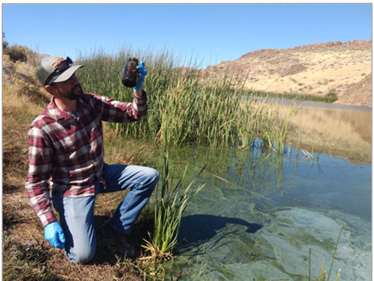 The Harmful Algal Bloom (HAB) Monitoring Program is implemented by several state agencies to carry out the responsibilities and procedures outlined in the HAB Strategic Response Plan (SRP).
The Harmful Algal Bloom (HAB) Monitoring Program is implemented by several state agencies to carry out the responsibilities and procedures outlined in the HAB Strategic Response Plan (SRP).
These agencies include, but are not limited to:
- Nevada Division of Environmental Protection (NDEP)
- Nevada Division of State Parks (NDSP)
- Nevada Division of Wildlife (NDOW)
- Nevada Department of Agriculture (NDA)
- Nevada Office of State Epidemiology (OSE)
The task force executes the HAB Monitoring Program goals through regular monitoring, sampling, and interagency communication. Monitoring and sampling consists of visual assessment in the field, desktop analyses of satellite data, and laboratory analysis of water samples. Monitoring and sampling are typically conducted during spring through summer months.
Recreational Health Advisory Levels, Exposure & Reporting
What guidelines does Nevada use for HABs?
There are currently no federal or state regulatory standards for cyanotoxins in recreational waters or drinking water. However, the Nevada Division of Environmental Protection developed a suggested voluntary guidance for responding to HABs in recreational waters based on the US Environmental Protection Agency’s (EPA) recommended Human Health Recreational Ambient Water Quality Criteria or Swimming Advisories for Microcystins, Cylindrospermopsin, and Anatoxina. Participating HABs Monitoring Program agencies are encouraged to follow this guidance when HABs pose a health threat.
How can I receive updated HAB advisories?
For weekly updates on HAB data and health advisories, please join the Nevada HABs e-mail list at the bottom of this webpage by clicking "Get Notices" and selecting "Nevada Harmful Algal Bloom Updates" from the dropdown menu, or you can send an e-mail directly to NEVADAHABS-subscribe-request@LISTSERV.STATE.NV.US
How can I learn more about HABs?
Who can I contact for more information about HABs?
For more information about HABs in Nevada, please contact the HAB Task Force:
Weston Fettgather, Supervisor, Environmental Scientist, Bioassessment Branch, BWQP at wfettgather [at] ndep.nv.gov
Veda Parker, Environmental Scientist, Bioassessment Branch, BWQP, vparker [at] ndep.nv.gov
To view the HAB Dashboard, visit The Office of State Epidemiology Harmful Algae Bloom Dashboard




